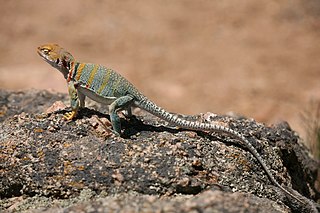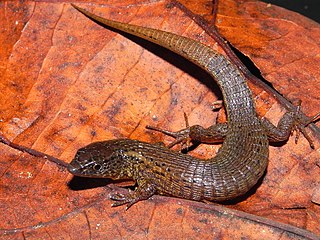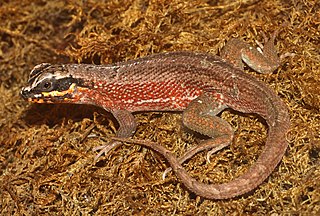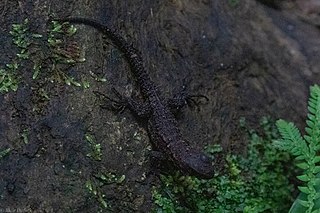
The Crotaphytidae, or collared lizards, are a family of desert-dwelling reptiles native to the Southwestern United States and northern Mexico. Alternatively they are recognized as a subfamily, Crotaphytinae, within the clade Pleurodonta. They are very fast-moving animals, with long limbs and tails; some species are capable of achieving bipedal running at top speed. This species is carnivorous, feeding mainly on insects and smaller lizards. The two genera contain 12 species.

The Iguanidae is a family of lizards composed of the iguanas, chuckwallas, and their prehistoric relatives, including the widespread green iguana.

Enyalioides is a genus of lizards in the family Hoplocercidae. The genus is native to the northern part of South America and Panama.
The spiny weapontail is a species of lizard belonging to the monotypic genus Hoplocercus in the family Hoplocercidae. The species is found in the Cerrado and adjacent Cerrado–Amazon mosaics in Brazil and Bolivia.

Alopoglossus is a genus of lizards in the monogeneric family Alopoglossidae. The genus is distributed from Costa Rica in Central America to northern South America.

Iguania is an infraorder of squamate reptiles that includes iguanas, chameleons, agamids, and New World lizards like anoles and phrynosomatids. Using morphological features as a guide to evolutionary relationships, the Iguania are believed to form the sister group to the remainder of the Squamata, which comprise nearly 11,000 named species, roughly 2000 of which are iguanians. However, molecular information has placed Iguania well within the Squamata as sister taxa to the Anguimorpha and closely related to snakes. The order has been under debate and revisions after being classified by Charles Lewis Camp in 1923 due to difficulties finding adequate synapomorphic morphological characteristics. Most iguanians are arboreal but there are several terrestrial groups. They usually have primitive fleshy, non-prehensile tongues, although the tongue is highly modified in chameleons. Today they are scattered occurring in Madagascar, the Fiji and Friendly Islands and Western Hemisphere.

Stenocercus is a genus of South American lizards, commonly called whorltail iguanas, of the family Tropiduridae. This genus has 80 valid described species.

Enyalioides groi, known commonly as Gro's manticore, Dunn's spinytail iguana, or Dunn's spinytail lizard, is a species of lizard in the family Hoplocercidae. The species is native to northwestern South America and Panama.

Enyalioides annularis, known commonly as the ringed manticore or the ringed spinytail iguana, is a species of lizard in the family Hoplocercidae. The species is endemic to northwestern South America.

Enyalioides laticeps, the Amazon broad-headed wood lizard, is a dwarf iguanian lizard abundantly found in Amazonian rainforests. They are semi-arboreal and mostly live in forests. Other names for it include broad-headed wood lizards, Big-headed stick lizards, Guichenot's Dwarf Iguana, Amazon Forest Dragon, or Amazon Dwarf-Iguana.
The Mohamed Bin Zayed Species Conservation Fund is an endowment that promotes species conservation worldwide headed by Mohammed bin Zayed Al Nahyan, the current ruler of Abu Dhabi and President of United Arab Emirates. The fund was established in October 2008 and became active in January 2009. It had an initial endowment of €25 million. Proceeds from the endowment are directed to projects to conserve threatened and endangered species of animals, plants and fungi around the world. It gave more than $2.4m in 2010 to 214 projects in almost 80 countries. From 2009 to summer 2019, the MBZ Fund has supported 1,982 projects with $18.5 million dollars across more than 150 countries.

Enyalioides azulae is a species of lizards in the family Hoplocercidae. It is known from only its type locality in the Cordillera Azul National Park in Peru.

Enyalioides binzayedi is a species of lizards in the genus Enyalioides known from only one location in the Cordillera Azul National Park in Peru. The lizard is named after Mohammed bin Zayed Al Nahyan, who sponsored the field survey that led to the discovery of the species.

Enyalioides sophiarothschildae, or the Rothschild's woodlizard, is a species of lizards in the family Hoplocercidae. It is endemic to the Amazonian slopes of the Cordillera Central in northeastern Peru. It differs from its congeneric species by possessing homogeneous (size) caudal scales on each caudal segment, a white gular region that has a black patch as well as turquoise scales in males, and immaculate white labials and chin.

Enyalioides anisolepis the rough-scaled woodlizard, is a species of lizards in the family Hoplocercidae. It is known from the Amazonian slopes of the Andes in southern Ecuador and northern Peru. It differs from its congeneric species by possessing scattered, projecting large scales on its dorsum, flanks, and hind limbs; a well-developed vertebral crest, with vertebrals on its neck being about three times in size compared to those between the animal's hind limbs.

Enyalioides altotambo, the Alto Tambo woodlizard, is a species of lizards in the family Hoplocercidae. It is endemic to the tropical northwestern Andes in Ecuador. It is named after its type locality, Alto Tambo in the Esmeraldas Province. It differs from its congeneric species by possessing smooth and homogeneous (size) dorsal scales, a brown iris, and lacking circular and keeled scales on its flanks.

Cercosaura oshaughnessyi, known commonly as the white-striped eyed lizard, is a species of lizard in the family Gymnophthalmidae. The species is endemic to northern South America.

Enyalioides cofanorum, also known commonly as the Cofan woodlizard, Duellman's dwarf iguana, and lagartija de palo cofanes in Spanish, is a species of lizard in the family Hoplocercidae. The species is native to northwestern South America.

Enyalioides oshaughnessyi, the red-eyed woodlizard or O'Shaughnessy's dwarf iguana, is a species of lizards in the family Hoplocercidae. It occurs in southern Colombia and northern Ecuador. The specific name oshaughnessyi honors Arthur O'Shaughnessy, a British herpetologist.
Enyalioides touzeti, also known as Touzet's woodlizard, is a species of lizard in the family Hoplocercidae. It occurs on the western Andean slopes of southwestern Ecuador and northern Peru.

















